|
|
|
Sort Order |
|
|
|
Items / Page
|
|
|
|
|
|
|
| Srl | Item |
| 1 |
ID:
091702


|
|
|
|
|
| Publication |
2009.
|
| Summary/Abstract |
Electricity demand in South Africa has grown at a very rapid rate over the past decade. As part of reform initiatives to enhance long-term sustainability of the country's electricity industry, South Africa's authorities have in recent years sought to develop an electricity pricing framework that is cost reflective and forms the cornerstone of demand management schemes meant to foster changes in consumption behaviour and enhance efficiency in resource use. The effects of any pricing policy on aggregate electricity consumption will depend on a useful understanding of the factors that influence electricity demand, and the magnitude to which electricity demand responds to changes in such factors. In this context, this paper applies the bounds testing approach to cointegration within an autoregressive distributed lag framework to examine the aggregate demand for electricity in South Africa during the period 1960-2007. The results indicate that in the long run, income is the main determinant of electricity demand. With electricity prices having an insignificant effect on aggregate electricity demand, future pricing policies will need to ensure that electricity prices are cost reflective and enhance efficiency of electricity supply and use.
|
|
|
|
|
|
|
|
|
|
|
|
|
|
|
|
| 2 |
ID:
093843


|
|
|
|
|
| Publication |
2010.
|
| Summary/Abstract |
In this paper, we test the differential effects of monetary policy shock on aspects of banks' balance sheets (deposits, loans, and securities) across bank categories (aggregate banks, state banks, and non-state banks) as well as on macroeconomic variables (output, consumer price index, exports, imports, and foreign exchange reserves). We do so by estimating VAR/VEC Models to uncover the transmission mechanisms of China's monetary policy. Also we identify the cointegrating vectors to establish the long-run relationship between these variables. By using monthly aggregate bank data and disaggregated data on bank and loan types from 1996 to 2006, our study suggests the existence of a bank lending channel, an interest rate channel and an asset price channel. Furthermore, we discuss and explore the distribution and growth effects of China's monetary policy on China's real economy. In addition, we investigate the effects of China's monetary policy on China's international trade. Finally, we identify the cointegrating vectors among these variables and set up VEC Models to uncover the long-run relationships that connect the indicators of monetary policy, bank balance sheet variables and the macroeconomic variables in China.
|
|
|
|
|
|
|
|
|
|
|
|
|
|
|
|
| 3 |
ID:
098054


|
|
|
| 4 |
ID:
091566
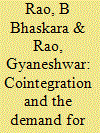

|
|
|
|
|
| Publication |
2009.
|
| Summary/Abstract |
Since the early 1970s, there has been a worldwide upsurge in the price of energy and in particular of gasoline. Therefore, demand functions for energy and its components like gasoline have received much attention. However, since confidence in the estimated demand functions is important for use in policy and forecasting, following [Amarawickrama, H.A., Hunt, L.C., 2008. Electricity demand for Sri Lanka: A time series analysis. Energy Economics 33, 724-739], this paper estimates the demand for gasoline is estimated with five alternative time series techniques with data from Fiji. Estimates with these alternative techniques are very close, and thus increase our confidence in them. We found that gasoline demand is both price and income inelastic.
|
|
|
|
|
|
|
|
|
|
|
|
|
|
|
|
| 5 |
ID:
086260
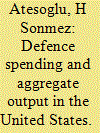

|
|
|
|
|
| Publication |
2009.
|
| Summary/Abstract |
In this article the effect of defense spending on aggregate output is discussed. Recent publications in this area are reviewed and new additional evidence is provided. The findings presented in this paper are supportive of the positive effect of defense spending. However, in light of the contrary evidence presented in other papers, empirical evidence taken as a whole, suggests that a definitive conclusion about the effect of defense spending at this time should be avoided.
|
|
|
|
|
|
|
|
|
|
|
|
|
|
|
|
| 6 |
ID:
129826


|
|
|
|
|
| Publication |
2014.
|
| Summary/Abstract |
Egypt plays a pivotal role in the security of the Middle East as the doorway to Europe and its military expenditure reflects its involvement in the machinations of such an unstable region, showing considerable variation over the last 40?years. These characteristics make it a particularly interesting case study of the determinants of military spending. This paper specifies and estimates an econometric model of the Egyptian demand for military spending, taking into account important strategic and political factors. Both economic and strategic factors are found to play a role in determining military burden/spending, with clear positive effects of lagged military burden, suggesting some sort of institutional inertia, plus negative output and net exports effects. The strategic effect as a result of the impact of Israel's military burden is mostly positive and significant, though its impact is reduced when the impact of important strategic events are taken into account. The military spending of Egypt's allies Jordan and Syria generally seems to have had no effect on Egypt's spending. These results are consistent over a range of econometric techniques.
|
|
|
|
|
|
|
|
|
|
|
|
|
|
|
|
| 7 |
ID:
117638
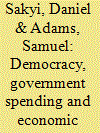

|
|
|
|
|
| Publication |
2012.
|
| Summary/Abstract |
Economic theory predicts a growth enhancing activities of various core functions of government. Nonetheless, government spending in non-democratic countries often goes beyond these core functions, namely into rent-seeking and non-productive activities. This paper employs the Autoregressive Distributed Lag bounds testing approach to cointegration to investigate the extent to which democracy and government spending have had an impact on economic growth in Ghana over the period 1960-2008. The empirical results obtained are encouraging, revealing support for the high effi ciency of government spending in democracies' hypothesis. The paper demonstrates that democracy and government spending go hand in hand to have a positive impact on economic growth in Ghana in both the long and short run. The fi ndings and policy recommendations of the paper provide vital information relevant for developing countries involved in the democratisation process.
|
|
|
|
|
|
|
|
|
|
|
|
|
|
|
|
| 8 |
ID:
187360


|
|
|
|
|
| Summary/Abstract |
This paper examines the main determinants of French defense spending over the period 1958–2017. To estimate the determinants of defense spending, the demand defense literature considers both economic and strategic factors such as conflicts, threats, and alliances. Our approach is original because we focus on strategic factors, including proxies for an alliance’s membership and external threats. In addition, we include transnational terrorism as a proxy for internal threats. We find that defense spending is positively related to the gross domestic product, North Atlantic Treaty Organization membership, military operations abroad, and external threats and negatively linked to the population as a proxy to public service needs. These results are robust to changes in specifications and shifts in defense policy observed after 1991. This contribution underlines that the fundamental determinants of defense policy in France are economic conditions.
|
|
|
|
|
|
|
|
|
|
|
|
|
|
|
|
| 9 |
ID:
141340


|
|
|
|
|
| Summary/Abstract |
Foreign direct investment (FDI) can play a significant role in achieving rapid economic growth in developing countries such as Sri Lanka. Even after the 30-year-long war that ended in 2009, the economy is still struggling to convince domestic and foreign investors that Sri Lanka is ‘ready for business’. In the light of this situation, identifying the factors that could influence FDI inflows into Sri Lanka is crucial to design policies aimed at attracting more FDI. This article empirically investigates the determinants of FDI inflows into Sri Lanka using annual data for the period 1978–2013 and applying the latest econometric techniques in time series analysis. As expected, market size, trade openness and infrastructure level have a positive impact, while wage and political instability have a negative impact on FDI. From a policy point of view, the results suggest that, to attract FDI inflows, Sri Lanka should develop and introduce policies that would improve the level of market size, trade openness, infrastructure and political stability but reduce the cost of labour.
|
|
|
|
|
|
|
|
|
|
|
|
|
|
|
|
| 10 |
ID:
107635
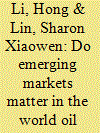

|
|
|
|
|
| Publication |
2011.
|
| Summary/Abstract |
This paper provides empirical evidence on the changing structure of world oil price system by identifying an additional driver-emerging market factor. We choose China and India as a representative of emerging markets to examine if the quantity of crude oil imported by China and India is significant in the existing oil pricing system (Kaufmann et al., 2004). Our data starts from January 2002 and ends in March 2010, which includes the oil shock of 2007-2008. We utilize cointegration and error correction model framework developed by Engle-Granger (1987) and Gregory-Hansen (1996) in the analysis. Our results indicate that demand from emerging markets has become a significant factor in the world oil pricing system since 2003. This result is significant as it lends empirical support to the widely held conjecture that the oil shock of 2007-2008 is a demand-led shock (Hamilton, 2009). Our result also has significant policy implications that go beyond the oil shock. The emerging market factor is there to stay and reflects the changing power between emerging and developed economies in the world economic system as a result of decades of fast economic development in the former. It will certainly influence policy issues related to oil and beyond.
|
|
|
|
|
|
|
|
|
|
|
|
|
|
|
|
| 11 |
ID:
119263


|
|
|
|
|
| Publication |
2013.
|
| Summary/Abstract |
This study revisits the relationship between defence spending and economic growth via a Keynesian model in Pakistan using the autoregressive distributive lag bounds testing approach to cointegration. Empirical evidence suggests a stable cointegration relationship between defence spending and economic growth. An increase in defence spending reduces the pace of economic growth confirming the validity of Keynesian hypothesis in this case. Current economic growth is positively linked with economic growth of previous periods while a rise in non-military expenditures boosts economic growth. Interest rate is inversely associated with economic growth. Finally, unidirectional causality running from military spending to economic growth is found.
|
|
|
|
|
|
|
|
|
|
|
|
|
|
|
|
| 12 |
ID:
084552
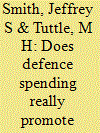

|
|
|
|
|
| Publication |
2008.
|
| Summary/Abstract |
Many studies have examined the relationship between defense spending and growth in real aggregate output with mixed results. Most recently, Atesoglu (2002) finds a positive relationship between defense spending and output. Capturing the error correction term as the long run adjustment parameter and including the long run adjustment in the relationship, we do not find evidence that defense spending promotes growth in real output. Instead, defense spending responds to aggregate income shocks. We re-estimated the relationship and dummied all US military conflicts with similar results concerning military spending's effect on output. Interestingly, we find trade-offs between defense and non-defense government spending during war time.
* The views expressed in this paper are those of the authors and do not necessarily reflect the official policy or position of the US Air Force, the Department of Defense, or the US Government. The authors would like to express their thanks for the comments from Craig Stone and the other participants at the 2006 Canadian Economics Association conference, as well the comments received from three anonymous referees and the editor.
|
|
|
|
|
|
|
|
|
|
|
|
|
|
|
|
| 13 |
ID:
121748


|
|
|
|
|
| Publication |
2013.
|
| Summary/Abstract |
This study reinvestigates the effect of defence spending on economic growth using Zivot and Andrews and Lee and Strazicich, structural unit root tests and the autoregressive distributed lag bounds testing approach to cointegration in augmented version of Keynesian model for India. Study confirmed long run relationship among variables studied show that economic growth is positively affected by defence spending (also negative impact after a threshold point), investment and trade openness while negatively by interest rate. Granger causality analysis revealed bidirectional causal relationship between defence spending and economic growth as probed by variance decomposition approach.
|
|
|
|
|
|
|
|
|
|
|
|
|
|
|
|
| 14 |
ID:
083228
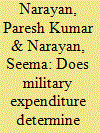

|
|
|
|
|
| Publication |
2008.
|
| Summary/Abstract |
Fiji's total debt stands at 65% of GDP. Domestic debt constitutes 55% of GDP. The goal of this paper is to investigate whether military expenditure has contributed to Fiji's exploding debt levels over the period 1970 to 2005. Our empirical analysis, conducted within a cointegration and vector error-correction framework, suggests that, in the long-run, military expenditure has had a statistically significant positive impact on both external debt and domestic debt, while income has had a statistically significant positive impact on domestic debt and a statistically significant negative impact on external debt. We explain the reasons behind this finding and draw some policy implications.
|
|
|
|
|
|
|
|
|
|
|
|
|
|
|
|
| 15 |
ID:
146509


|
|
|
|
|
| Summary/Abstract |
This paper investigates the effect of military spending on external debt in case of Pakistan for the period of 1973–2009. For this purpose, the autoregressive distributed lag bounds testing approach to cointegration is used to examine cointegration among the variables. The ADF, P-P, and ADF-GLS unit root tests are applied to test the integrating order of the variables. The Ordinary Least Square (OLS) and error correction method regressions are used to investigate the marginal impact of military spending on external debt in the long and short run. Our findings indicate the existence of cointegration that confirms the presence of a long-run relationship among military spending, external debt, economic growth, and investment. Further, our results reveal that a rise in military spending increases the stock of external debt; an increase in investment also increases external debt; however, there is an inverse effect of economic growth on external debt. An implication of the findings reported herein is that there is a need to formulate a comprehensive economic policy for curtailing external debt in case of Pakistan.
|
|
|
|
|
|
|
|
|
|
|
|
|
|
|
|
| 16 |
ID:
150028
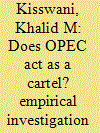

|
|
|
|
|
| Summary/Abstract |
In this paper I use quarterly and monthly data from 1994 to 2014 to test if OPEC acts as a cartel, and therefore, it affects oil prices through members' coordination. I use Engle and Granger two-step approach, Johansen cointegration test and Autoregressive Distributed Lag (ARDL) bounds testing approach of cointegration to examine the long-run relation between OPEC production and each member's production as an evidence of coordination. Besides, I apply Granger causality and Toda and Yamamoto tests to check the direction of causality between the OPEC production and oil prices (U.K. Brent and Dubai Fateh). The findings show no evidence of cointegration between the production of the members and that of OPEC, indicating no cartel behavior exists. Moreover, the results show that OPEC production does not cause oil prices; rather it is the other way around.
|
|
|
|
|
|
|
|
|
|
|
|
|
|
|
|
| 17 |
ID:
113474


|
|
|
|
|
| Publication |
2012.
|
| Summary/Abstract |
This paper examines cointegration relationships and Granger causality nexus in a trivariate framework among oil consumption, economic growth and international oil price in Portugal. For this purpose, we employ two Granger causality approaches: the Johansen cointegration test and vector error correction model (VECM) and the Toda-Yamamoto approaches. Cointegration test proves the existence of a long run equilibrium relationship among these variables and VECM and Toda-Yamamoto Granger causality tests indicate that there is bidirectional causality between crude oil consumption and economic growth (feed back hypothesis). Therefore, the Portuguese economy does not support crude oil conservation hypothesis. Consequently, policymakers should consider that implementing oil conservation and environmental policies may negatively impact on the Portuguese economic growth.
|
|
|
|
|
|
|
|
|
|
|
|
|
|
|
|
| 18 |
ID:
105783
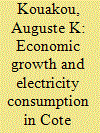

|
|
|
|
|
| Publication |
2011.
|
| Summary/Abstract |
This paper examines the causal relationship between the electric power industry and the economic growth of Cote d'Ivoire. Using the data from 1971 to 2008, a test was conducted for the cointegration and Granger causality within an error correction model. Results from these tests reveal a bidirectional causality between per capita electricity consumption and per capita GDP. A unidirectional causality running from electricity consumption to industry value added appears in the short run. Economic growth is found to have great effects on electricity consumption and a reverse causality from electricity to economic growth may also appear. In the long run, there is a unidirectional causality between electricity and both GDP and industry value added. From these findings, we conclude that the country will be energy dependent in the long run and must therefore secure the production network from shortfalls to ensure a sustainable development path. Accordingly, government should adopt policies aimed at increasing the investment in the sector by stepping up electricity production from existing and new energy sources.
|
|
|
|
|
|
|
|
|
|
|
|
|
|
|
|
| 19 |
ID:
094400
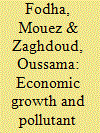

|
|
|
|
|
| Publication |
2010.
|
| Summary/Abstract |
This paper investigates the relationship between economic growth and pollutant emissions for a small and open developing country, Tunisia, during the period 1961-2004. The investigation is made on the basis of the environmental Kuznets curve hypothesis, using time series data and cointegration analysis. Carbon dioxide (CO2) and sulfur dioxide (SO2) are used as the environmental indicators, and GDP as the economic indicator. Our results show that there is a long-run cointegrating relationship between the per capita emissions of two pollutants and the per capita GDP. An inverted U relationship between SO2 emissions and GDP has been found, with income turning point approximately equals to $1200 (constant 2000 prices) or to $3700 (in PPP, constant 2000 prices). However, a monotonically increasing relationship with GDP is found more appropriate for CO2 emissions. Furthermore, the causality results show that the relationship between income and pollution in Tunisia is one of unidirectional causality with income causing environmental changes and not vice versa, both in the short-run and long-run. This implies that an emission reduction policies and more investment in pollution abatement expense will not hurt economic growth. It could be a feasible policy tool for Tunisia to achieve its sustainable growth in the long-run.
|
|
|
|
|
|
|
|
|
|
|
|
|
|
|
|
| 20 |
ID:
165371
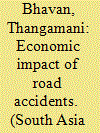

|
|
|
|
|
| Summary/Abstract |
The purpose of this study is to disclose accident-related indices and investigate the extent to which the road accidents impact on the economic performance of Sri Lanka during the period from 1977 to 2016. Annual time-series data are used to evaluate the accident indices for econometric analysis. Augmented Dickey–Fuller (ADF) unit root analysis and Johansen’s maximum likelihood estimator of the parameters of a cointegrating vector error correction model (VECM) are employed to test the stationary properties of the time series and to examine the long-run relationship between the variables, respectively. The results derived from the analysis confirm the existence of long-run relationship between the accident-related indices and macroeconomic indicators. The long-run elasticity values imply the signs and magnitude of impact of the accident indices on macroeconomic indicators.
|
|
|
|
|
|
|
|
|
|
|
|
|
|
|
|
|
|
|
|
|